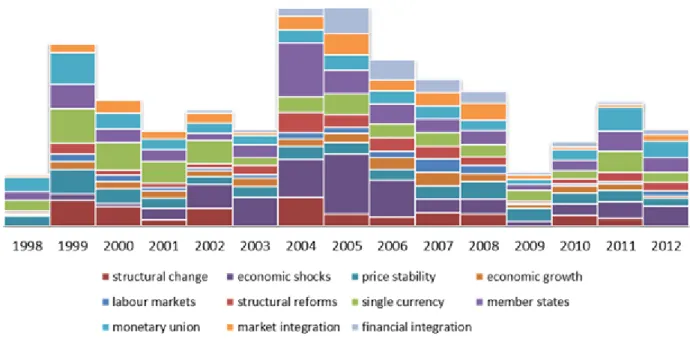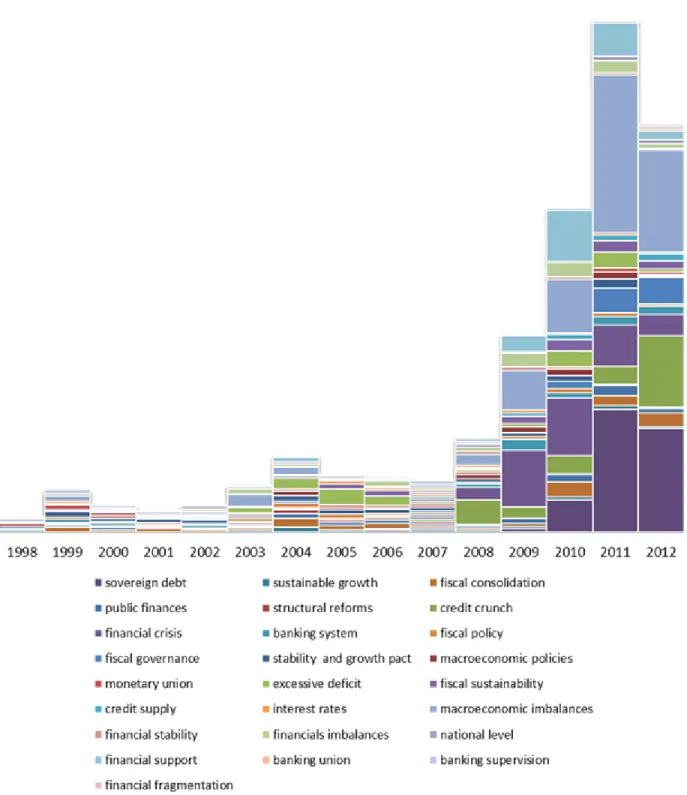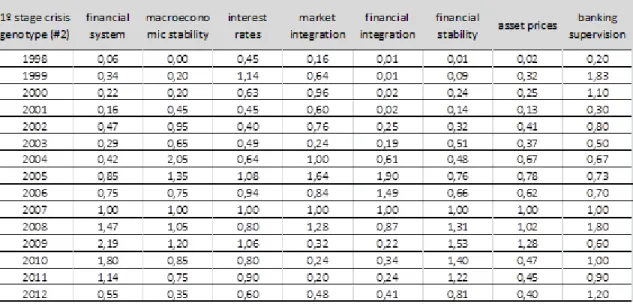CIES e-Working Paper N.º 177/2014
A first approach for depicting economic narratives propagated by Central Banks
in the formation and diffusion of expectations
Bruno Gaminha & Jorge Louçã
CIES e-Working Papers (ISSN 1647-0893)
1
Bruno Gaminha is a PhD student at ISCTE-IUL, Doctoral Program in Complexity Sciences, where he
develops his research "Formation and Diffusion of Economic Expectations - Complex and Heterogeneous Social Dynamics". He obtained the ISCTE-IUL merit ward for the best master dissertation in 2012, with "Optimal Monetary Policy and the process of formation and diffusion of heterogenic expectations". He is presently Assistant Research Professor of Complexity in Economics at the IIT-Indian Institute of Technology, Gandhinagar. Email: gaminha@gmail.com; The Observatorium - ISCTE-IUL Lisbon University Institute (http://theobservatorium.eu )
Jorge Louçã teaches Computer Science at the IUL - Lisbon University Institute, where he runs the
Master and Doctoral Programs in Complexity Sciences. His PhD is in Artificial Intelligence from the Université Paris Dauphine, Paris, France and the Faculty of Sciences of the University of Lisbon, Portugal. He coordinates The Observatorium research team and his research interests concern modelling complex social systems through intensive data collection and analysis. He is particularly interested by knowledge generation models in large-scale communication networks. Recently he participated in the creation of the UNESCO Unitwin network for the Complex Systems Digital Campus, involving institutions from Africa, Latin America and Europe. Email:
jorge.l@iscte.pt; The Observatorium - ISCTE-IUL Lisbon University Institute (http://theobservatorium.eu )
Abstract
A mechanism for depicting the economic narratives based on an evolutionary analogy is here proposed, in which the narrative is the phenotype or observable characteristics and its genotype is formed by a set of relevant concepts, defined by the researcher and constrained by the underlying reality. The genotype of the economic narrative evolves, assuming different quantitative impacts in the narrative, and is subject to mutations (creation of new or alter genotypes). The result of this evolutionary process is the emergence of temporally determined economic narratives.
2
Introduction
This research explores the processes of formation and diffusion of economic expectations, not as purely rational processes frameworked by a notion of representative agent, such as proposed by the rational expectations hypothesis [10], but as the product of a process anchored in social dynamics of complex and heterogeneous opinion. The main question deals with the process of formation and diffusion of economic expectations influenced by public narratives.
As stated by Hayden White, a “narrative is a metacode, a human universal on the basis of which transcultural messages about the nature of a shared reality can be transmitted” [5, p. 6]. The choice of narratives as a key concept to understand the social construction of economic expectations derives from the anthropological concept that an important function of human interaction is the construction of social representations. Social representations of the evolution of the world, and of the economy, contain facts and opinions, as well as all the relationships between them. These constructions can be described through a network-like formalism, where the links represent the relations between elements. Economic expectations relates, in an aggregated social level, to the understanding of shared economic realities, and of the dynamic evolution of these realities through constructs of meaning such as narratives, as a way of structuring economical significant events, actions and memories.
Specifically, this research is focused on the evolution of the economic narratives arising in the context of the world financial and economic crisis started in 2007. For this purpose the main economical narratives, contained in the keynotes of the European Central Bank board members, were identified. The evolution of narratives within these texts was captured, representing their trajectories as they evolve under the influence of critical events.
Defining and representing narratives propagated during the crisis
According to the Vice-President of the European Central Bank (ECB) Vítor Constâncio [11], when describing the response of the ECB to the crisis, the ECB had to respond to two different types of challenges, the systemic challenges and the acute challenges - defined as shifts in investors sentiments and market psychology. These sentiments and expectations are determinant in the economic development. Aiming to achieve their political and economic goals, Central Banks try to frame the expectations of the economic agents about the economic reality, and by doing so, to constrain their behaviour.
3
The economic crisis started in 2007 constitutes a particularly interesting period, not only because of the active role taken by the Central Banks in the different stages of the crisis [7], but also because of the rupture with the basic assumptions underlying the central bank consensus, imposing a major rethinking on the role of these entities [6, 7, 8]. According to Gros, Alcidi and Giovanni [1], the response to the crisis of the ECB should be divided in two stages: a first one corresponding to the burst of the financial crisis (2007 - 2009), and a second stage of the crisis (2010 - 2012) having unique characteristics in the euro area, and thus requiring specific actions from the ECB. We propose and implement a methodology to determine narratives that emerged from ECB, distinguishing the two stages of the crisis.
Following the construction of narratives as a network of events proposed by Berman, Moody and Faris [2], complex sets of interrelated concepts and events are considered. By treating concepts and events as nodes and relations between concepts and events as arcs, sets of concepts are transformed into networks. This symbolic construction of concept relational structures into networks allows observing and measuring structural features of narratives, that are otherwise difficult to detect, and proposing a narrative mapping for the social construction of economic expectations that the ECB tried to frame during the crisis.
We propose a mechanism of economic narratives representation based on an evolutionary analogy. In the genetics biology domain, a genotype is a set of genes. A biological entity’s phenotype is composed of all of its observable characteristics, and is the result of both its genotype and of the environment. The evolutionary approach studies the changes in the genotypes that make up a population from generation to generation and its combined effect with the environment in impacting the observable phenotypes.
In our analogy, the narrative is considered to be the phenotype or observable characteristics and its genotype is formed by a set of relevant concepts, defined by the researcher and constrained by the underlying reality. The genotype of the economic narrative evolves, assuming different quantitative impacts in the narrative, and is subject to mutations (creation of new or alter genotypes). The result of this evolutionary process is the emergence of temporally determined economic narratives. This analogy supports the methodology detailed as follows.
Methodology
All 1858 keynotes from the EU Central Bank, published from its foundation in 1998 to 2012, were gathered and studied [3]. By analysing the number of times an explicit reference to the different concepts appeared in the keynotes, we defined a collection of the relevant concepts composing the genotype emerging from the ECB keynotes during this period (cf. table 1).
4
Table 1. Genotype of the ECB narrative (1998-2012)
Based on the genotype that span the conceptual space, we measured the number of times that the concepts have been used in the ECB keynotes in each year (cf. tables 2 to 8), using the 2007 number of occurrences as a normalizing constant. By doing so, the relevant genotype of the ECB narrative, and its evolution in each time frame, was detected (cf. figures 1, 2 and 3). The narrative genotype in question was depicted in three periods. A first longer one, ranging from 1998 (the year of ECB foundation) to 2006 (the last year before the setting of the crisis, according to Gros, Alcidi and Giovanni’s time frames), served the purpose of control group. In the following two periods, the response to the crisis of the ECB was split in two stages [1]: the first following the burst of the financial crisis (2007 - 2009), and the second one (2010 - 2012) requiring specific actions from the ECB.
After finding the most relevant economic concepts, i.e., those appearing more often in the ECB’s keynotes, since the ECB’s foundation to 2012 (cf. Table 1), the concepts were grouped according to their incidence in the each of the periods. Through this process, we found that the narrative genotype changed in the different periods, as follows:
During the pre-crisis period (1998-2006), the ECB narrative has its genotype formed by the concepts: structural change; economic shocks; price stability; economic growth; labour markets; structural reforms; single currency; member states; monetary union; market integration and financial integration (see Figure 1).
5
Figure 1. Narrative genotype in the pre-crisis years (1998-2006)
During the first stage of the crisis (2007-2009), the ECB narrative has its genotype formed by the concepts: financial turbulences; price stability; economic growth; labour markets; sustainable growth; structural reforms; inflationary pressures; fiscal stimulus; job creation; financial system; macroeconomic stability; interest rate; market integration; financial integration; financial stability; asset prices and banking supervision.
6
Figure 2. Narrative genotype in the years of the 1º stage of the crisis (2007-2009)
During the period 2010-2012 the ECB narrative has its genotype formed by the concepts: sovereign debt; sustainable growth; fiscal consolidation; public finances; structural reforms; credit crunch; financial crisis; banking system; fiscal policy; fiscal governance; stability and growth pact; macroeconomic policies; monetary union; excessive deficit; fiscal sustainability; credit supply; interest rates; macroeconomic imbalances; financial stability; financial imbalances; national level; financial support; fiscal consolidation; banking union; banking supervision and financial fragmentation.
7
8
From the shifts detected in the genotype pattern, one can reconstruct the economic narrative and, by doing so, its relation with the underlying economic reality becomes self-evident.
As an illustrative example, in the second stage of the crisis the main concepts arising are ‘sovereign debt’, ‘credit crunch’ and ‘macroeconomic imbalances’, while the strong concepts in the first stage are ‘financial turbulence’ and ‘fiscal stimulus’. These different genotypes arising do influence, in each particular moment of the onset crisis, the emergent economic narrative emerging from the ECB, whether as an adaptive response to the environment or as a way to try to influence it, by framing the economic agents’ expectations.
Conclusion
The Central Banks try to frame the expectations of the economic agents on the economic reality and, by doing so, constrain their behaviour by taking an active role in the process of formation and diffusion of economic narratives. Using the keynotes of the European Central Bank board members, we explored the evolution of the economic narratives arising in the context of the world financial and economic crisis started in 2007 and represented their trajectories as they evolved under the influence of critical events.
A mechanism for depicting the economic narratives based on an evolutionary analogy has been proposed, in which the narrative is the phenotype or observable characteristics and its genotype is formed by a set of relevant concepts constrained by the underlying reality. The genotype economic narrative has been detected as it evolves over the first and second stages of the economic and financial crisis. The main conclusion is that there is a mutation on the genotype, as the crisis evolves, that brings about concepts such as ‘financial turbulence’ and ‘fiscal stimulus’ in the first stage and ‘sovereign debt’ or ‘credit crunch’ further down the road, with greater intensity.
Next steps of this research will try to capture the replication mechanisms propagating economic narratives. Implications of narratives on public policies and on economic aggregates will also be studied.
9
References
[1] Gros, D., Alcidi , C. & Giovannini, A. (2012), “Central Banks in Times of Crisis: The FED vs. the ECB”, CEPS Policy Brief No 276, CEPS, Brussels, July.
[2] Berman, P., Moody, J. & Faris, R. (2002), “Networks and History”, Complexity. 8(1): 61-71. [3] http://www.ecb.int/press/html/index.en.html
[4] http://www.federalreserve.gov/newsevents/default.htm
[5] White, H. (1980) "The Value of Narrativity in the Representation of Reality," Critical Inquiry, No. 1, pp. 5-27.
[6] Mishkin, F. S., “Central Banking After the Crisis,” in Central Bank of Chile, Monetary Policy and Financial Stability, Sixteenth 16th Annual Conference of the Central Bank of Chile (Central Bank of Chile: Santiago, forthcoming).
[7] IMF (2010), “Central Banking Lessons from the Crisis,” IMF Policy Paper.
[8] Shirakawa, M. (2012), “Central Banking: Before, During, and After the Crisis,” Remarks at A Conference Sponsored by the Federal Reserve Board and the International Journal of Central Banking.
[9] http://www.economist.com/
[10] Stiglitz, J. & Gallegati, M. (2011), “Heterogeneous Interacting Agent Models for Understanding Monetary Economies”, Eastern Economic Journal, 37(1), pp. 6-12.
[11] Contâncio, V. (2013), “The global financial crisis - 5 years on”, in China-Europe Economists Symposium, Beijing, January
10
Annex
Table 2. Number of references to the narrative genotype in the pre-crisis years #1, 2007=1
11
Table 4. Number of references to the narrative genotype in the years of the 1º stage of the crisis #1, 2007=1
Table 5. Number of references to the narrative genotype in the years of the 1º stage of the crisis #2, 2007=1
12
Table 6. Number of references to the narrative genotype in the years of the 2º stage of the crisis #1, 2007=1
Table 7. Number of references to the narrative genotype in the years of the 2º stage of the crisis #2, 2007=1
13
Table 8. Number of references to the narrative genotype in the years of the 2º stage of the crisis #3, 2007=1







